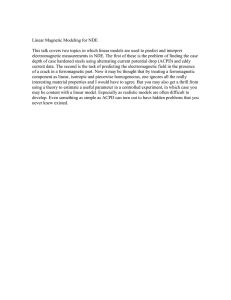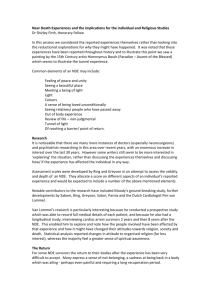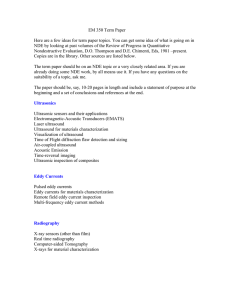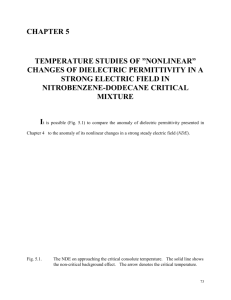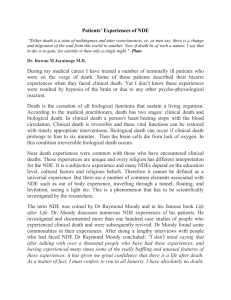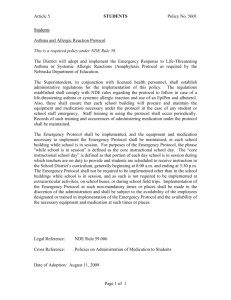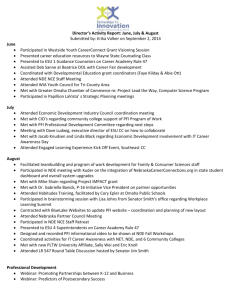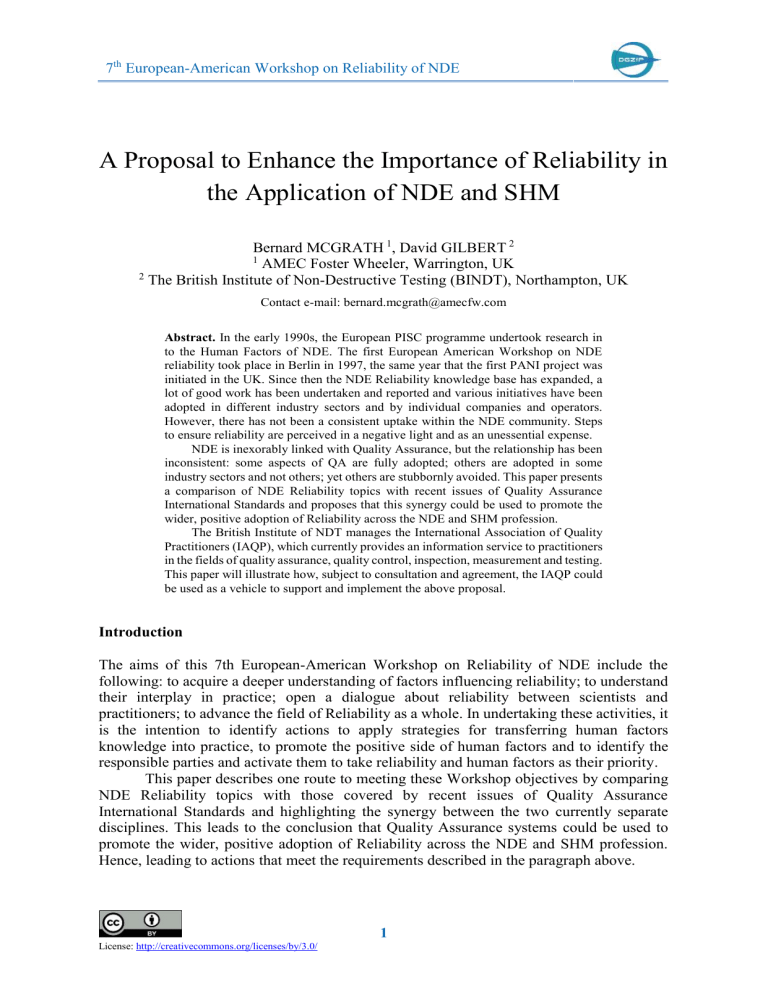
7th European-American Workshop on Reliability of NDE A Proposal to Enhance the Importance of Reliability in the Application of NDE and SHM Bernard MCGRATH 1, David GILBERT 2 AMEC Foster Wheeler, Warrington, UK 2 The British Institute of Non-Destructive Testing (BINDT), Northampton, UK 1 Contact e-mail: bernard.mcgrath@amecfw.com Abstract. In the early 1990s, the European PISC programme undertook research in to the Human Factors of NDE. The first European American Workshop on NDE reliability took place in Berlin in 1997, the same year that the first PANI project was initiated in the UK. Since then the NDE Reliability knowledge base has expanded, a lot of good work has been undertaken and reported and various initiatives have been adopted in different industry sectors and by individual companies and operators. However, there has not been a consistent uptake within the NDE community. Steps to ensure reliability are perceived in a negative light and as an unessential expense. NDE is inexorably linked with Quality Assurance, but the relationship has been inconsistent: some aspects of QA are fully adopted; others are adopted in some industry sectors and not others; yet others are stubbornly avoided. This paper presents a comparison of NDE Reliability topics with recent issues of Quality Assurance International Standards and proposes that this synergy could be used to promote the wider, positive adoption of Reliability across the NDE and SHM profession. The British Institute of NDT manages the International Association of Quality Practitioners (IAQP), which currently provides an information service to practitioners in the fields of quality assurance, quality control, inspection, measurement and testing. This paper will illustrate how, subject to consultation and agreement, the IAQP could be used as a vehicle to support and implement the above proposal. Introduction The aims of this 7th European-American Workshop on Reliability of NDE include the following: to acquire a deeper understanding of factors influencing reliability; to understand their interplay in practice; open a dialogue about reliability between scientists and practitioners; to advance the field of Reliability as a whole. In undertaking these activities, it is the intention to identify actions to apply strategies for transferring human factors knowledge into practice, to promote the positive side of human factors and to identify the responsible parties and activate them to take reliability and human factors as their priority. This paper describes one route to meeting these Workshop objectives by comparing NDE Reliability topics with those covered by recent issues of Quality Assurance International Standards and highlighting the synergy between the two currently separate disciplines. This leads to the conclusion that Quality Assurance systems could be used to promote the wider, positive adoption of Reliability across the NDE and SHM profession. Hence, leading to actions that meet the requirements described in the paragraph above. 1 License: http://creativecommons.org/licenses/by/3.0/ 1. NDE Reliability In 1997 [1] a conceptual model was agreed which expressed reliability as a formula: R = IC + AP + HF, where IC is the intrinsic capability of the physical principles behind inspection technique and the maximum performance that can be achieved; AP is the application factors which impact on the capability, such as ultrasonic coupling, restrictions on access and the noise from the surroundings; and HF is the human factors which are present in every application. This representation of Reliability as an equation implies that Reliability can be quantified and expressed as a value. As a result there has subsequently been a focus on Probability of Detection (PoD) and this may have overshadowed the qualitative components. The Second European American Workshop on NDE Reliability, held in 1999 [2], gave a clear definition of NDE reliability as the degree that an NDE system is capable of achieving its purpose regarding detection, characterization and false calls. The NDE system was also defined as the procedure, equipment and personnel that are used in performing an NDE inspection. This model was subsequently developed and refined into the Modular Reliability Model [3], which is shown in Figure 1 and goes someway to illustrating Reliability as a process. The model continues to be refined in the light of new knowledge. Figure 1 Modular Model of Reliability There has been over 40 years of round robin exercises, starting in 1976 with PISC 1 and the NORDTEST trials and continuing with DDT, PISC II, PISC III, NIL, ICON and PANI, which have shown that the reliability of NDE is variable. Smaller round robin exercises aimed at specific applications are still being conducted and delivering the same result. As a result of these trials and prior to the establishment of the definition of NDE Reliability, the individual constituents had been treated separately: IC and AP where addressed in the development of inspection validation, subsequently renamed inspection qualification, in the 1980s and 1990s; HF was the subject of detailed studies in the late 1980s and early 1990s and a lot of work has been undertaken since to identify the issues and to propose solutions [4]. These solutions include the following: Guidance documents Helping operator avoid fatigue Assist in developing operator competence Job and operator specific training Improving the operator’s self-awareness Mitigating environmental factors Managing perception of time pressure 2 Optimising the inspection procedure Optimising the interaction with automated systems Better planning and better management of the NDE process The initial approach to encourage adoption by industry identified the negative impacts of Human Factors i.e. the poor results that could be delivered if steps were not taken. The recommendations to avoid such poor results were aimed at NDE Vendor & NDE User community. More recently the Reliability community has been looking at promoting the positive aspects and providing recommendations for what the individual operator can do to improve the reliability of his / her inspection. Yet the adoption of mitigations for the Human Factors effect on the reliability of the NDE still remains ad hoc. Quality Assurance and NDE It is worth reminding ourselves of the purpose of Quality and Quality Assurance. The ISO standard definition of Quality is the “degree to which a set of inherent characteristics of an object fulfils requirements” [5]. A slightly more explicit definition is “the totality of features and characteristics of a product or service that bears its ability to satisfy stated or implied needs”. Similarly, the ISO standard definition of quality assurance is that “part of quality management focused on fulfilling quality requirements”. Again a more explicit definition is “the maintenance of a desired level of quality in a service or product, especially by means of attention to every stage of the process of delivery or production”. From these definitions it is easy to see how NDE contributes to the quality assurance of manufactured products and to the continued assurance that plant can satisfy its need to continue operating. When it comes to the quality of NDE and the application of quality assurance to what is already viewed as a quality assurance activity, the perceived need to adopt various activities to ensure stated and implied needs is inconsistent across different industries. You could argue that the needs are not always stated and the implied ones may not always what they should be. In 2014 Holstein [6] reported the results of a questionnaire of NDE Vendor companies in Germany. When asked their main approach to quality management, 34% of the respondents cited ISO 17025 [7], 21% cited ISO9001 [8], 10% cited ISO 1720 [9] whilst 28% relied on customer audits. This variety of approaches is not a bad thing because the value of QA is maximised when it is appropriate to services provided by an organisation. However, across the NDE industry as a whole, the application of QA in NDE is inconsistent. This is best illustrated by looking at some of the requirements of ISO9001. Note that the other standards ISO 17025 and 17020 complement ISO 9001. Competence of personnel: It is widely accepted that the competence of operators needs to be supported by certification to a scheme such as those based on ISO 9712 [10] or ASNT SN-TC-1A [11] and this is universally implemented. However, as was illustrated in the reliability section above, certification alone does not address competence completely. Design: The historic basis of NDE has been in manufacturing and, following manufacturing practices, NDE has been applied in accordance with National and International standards. This has led to a view that NDE is a standard service which doesn’t need a design process. However, it is 3 only recently that standards for In Service Inspection have been considered and whilst some design of inspections is undertaken, there is little discussion around what an NDE design process should look like. The design process begins with an input statement of requirements for the product or service. When such a document has been generated under other processes such as Risk Based Inspection (RBI), it has been reported that the subsequent inspection has been improved because “the operators know what they are looking for”! Even in the absence of design, ISO 9001 requires that the requirements for the products and services are defined. In the nuclear industry, Inspection Qualification (IQ) has been adopted to provide confidence in the capability of the inspection system. The qualification process requires the existence of an inspection procedure. A comparison of the ISO 9001 design process and the IQ process shows that IQ is often just fitting the design process in retrospect: if NDE had a design process then qualification would be the assessment of the design dossier. Verification and validation are part of any ISO 9001 design process. Operation: Whilst a design process in NDE has not been adopted, there has been movement on addressing NDE as a special process, particularly within the aerospace community. NDE is, in QA terms, a special process and ISO 9001 requires the validation, and periodic revalidation, of the ability to achieve planned results of such processes. However, this has not been widely adopted within the NDE community, being perceived as an additional expense burden on an already reluctant purchase. Reliance on NDE standards is not a robust alternative: standards often offer alternative options for parameters. It is important to ensure that the correct parameters are applied and that the particular standard is applicable to the specific inspection. In addition to requiring “the implementation of actions to prevent human error”, the recent update of ISO 9001:2015 has added a clause on the “Environment for the operation of processes”, (Section, 7.1.4) and specifies the need to determine, provide and maintain the environment necessary to achieve conformity. A suitable environment can be a combination of social, psychological and physical factors on the quality of the process. So QA now demands that Human Factors are considered and controlled. From the above, it can be seen that If QA principles were followed, then the following would be performed for every inspection: There would be a specification for the inspection – either design specification or customer requirements. This would lead to documented information that defines the activities to be performed and the results to be achieved. The process (equipment, personnel and procedure) would be validated – either in the design process or as part of a special process. The personnel would be competent and put to work – appointment of competent persons Actions would be implemented to prevent human error. The knowledge necessary for the operation of the processes shall be determined, maintained and made available. If we go beyond ISO 9001 and look at ISO 17025 then this reinforces the above, as well as raising other specific requirements such as: practicable measures to prevent unintended adjustments of equipment which would invalidate results (Human Factors, ergomomics); evaluation of measurement uncertainty (sizing errors analysis & POD). The diagram given in ISO 17025 provides a good visual summary of all the requirements. 4 NDE Reliability and QA The connection between QA and Reliability is clearly observed through the three factors of the reliability model. The intrinsic capability and the application of the NDE technique are addressed by the specification of requirements and the need to establish that the service can meet these needs. The human factors are addressed by the management and organisational requirements as well as the need to establish competent personnel to deliver the service. These links have been strengthened by the recent updates to ISO 9001, which, through the requirement to address the environment of the service delivery, have addressed more of the human factors issues. Figure 2 shows the QA activities on the Reliability Modular Model. Figure 2 Reliability Modular Model with Supporting QA Activities Two stated objectives of the 2017 Reliability Workshop are: to develop strategies for transferring human factors knowledge into practice; to identify the responsible parties and activate them to take reliability and human factors as their priority. QA offers the vehicle to get improvements to reliability implemented by the parties responsible for both the management and the application of the NDE. Reliability work is required to provide the body of knowledge to support the appropriate QA actions. In order to encourage responsible parties to take reliability and human factors as their priority it is proposed, in the UK, to use an existing organisation administered by the British Institute of NDT (BINDT): the International Association of Quality Practitioners (IAQP). The IAQP currently provides an information service to practitioners in the fields of quality assurance, quality control, inspection, measurement and testing. However, in recent years the unique benefits of the IAQP have diminished through integration into the wider BINDT membership offering and there have been a number of discussions held about how to readdress the difference. The overlap of QA and NDE Reliability described above and the stated need to encourage adoption of human factors / reliability improvements provides an opportunity to re-launch the IAQP with an initial objective of providing fora for all personnel (operator, specialist, manager or academic) with a specific interest in QA / NDE Reliability. The aims would be to promote the professional status of the practice of quality assurance in NDE & CM and to promote the practice of quality assurance principles to deliver the benefits of improved reliability of application. These would be achieved through the 5 dissemination of knowledge and best practice. The details and practicalities of how this potentially re-packaged IAQP will operate will need to be discussed and agreed both within the UK and, if it is to live up to its international tag, with interested parties overseas. Conclusion This paper has illustrated that quality assurance and NDE reliability suffer from the same indifference and inconsistent application within the NDE industry. Yet the two disciplines are both focused on the same goal: specifically that the applied NDE achieves the necessary requirements expected from it. The output from NDE reliability studies can be implemented through the adoption of quality assurance, in line with the recent updates in the International quality management standards. The challenge to be addressed is how to encourage application in day-to-day operations. One possible way forward, proposed for the UK, is to use an existing organisation, the IAQP, as a vehicle to disseminate Reliability knowledge and best practice. How Reliability can be implemented through quality assurance activities will be illustrated and the professional status of practitioners in the field will be promoted. Please let the authors know your views and comments. References [1] C. Nockemann and C. Fortunko, “Summary of the workshop,” in Proceedings of the European-American Workshop: Determination of Reliability and Validation Methods on NDE, 18-20 June 1997, Berlin, Germany, Berlin: DGZfP, 1997, pp. 11–17 [2] ASNT Topical Conference Paper Summaries Book of the American European Workshop on NonDestructive Inspection Reliability, September 21-24 (1999), NIST, Boulder, CO, USA, ISBN: 1 57117 041 3 [3] C. Müller, M. Bertovic, M. Pavlovic, D. Kanzler, U. Ewert, J. Pitkänen, and U. Ronneteg, “Paradigm Shift in the Holistic Evaluation of the Reliability of NDE Systems,” Materials Testing, vol. 55, no. 4, pp. 261–269, 2013. [4] B McGrath, R Holstein and M Bertovic, “How NDT Companies Can Benefit From Human Factors Knowledge”, 19th World Conference on Non-Destructive Testing, Munich, 2016 [5] BS EN ISO 9000:2015 Quality management systems Fundamentals and vocabulary [6] “Organizational Practice Of NDT In Service Inspection Companies”, Holstein, R, 11th European Conference on Non-Destructive Testing, (ECNDT 2014), Prague, Czech Republic 6-10 October 2014. [7] BS EN ISO/IEC 17025:2005 General requirements for the competence of testing and calibration laboratories June 2005 [8] BS EN ISO 9001:2015 Quality management systems. Requirements September 2015 [9] BS EN ISO/IEC 17020:2012 Conformity assessment. Requirements for the operation of various types of bodies performing inspection March 2012 [10] BS EN ISO 9712:2012 Non-destructive testing. Qualification and certification of NDT personnel June 2012 [11] ASNT Recommended Practice No. SNT-TC-1A: Personnel Qualification and Certification in Nondestructive Testing 2016 6
